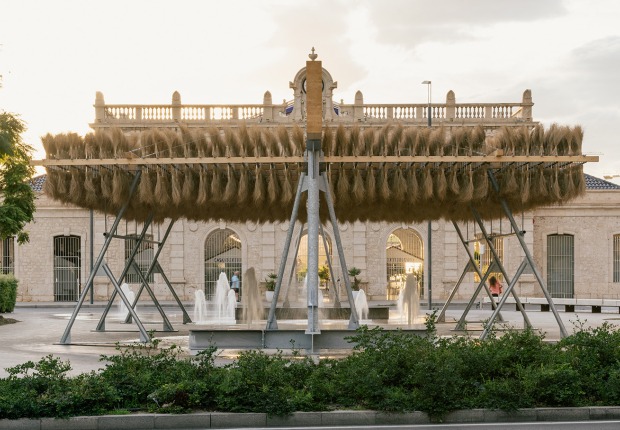The chosen site, the Czechoslovak Hussite Church in Hradec Králové, is a sacred building that was built in the 1920s. Designed by Josef Gočár, it shows a journey developed by the architect, ranging from brick and structured individualistic modernity to crisp, sharp angles and areas of functionalism.
Description of project by Petr Dub
Author’s note – Petr Dub
Sentences after Conceptual Art represent a bridge between the language of knowledge and the doctrines of knowledge. The original Sol Lewitt’s Sentences on Conceptual Art, first published in 1969, became an iconic text for the modernist understanding of art. A text as figurative as it is confused with a comprehensive and, above all, rationalist instruction on how to understand and interpret conceptual art. In addition to professional agreements, the original text also works with the concepts of irrationality, subjectivity and mysticism. It is radical in itself, while its legacy has become extreme. Owing to Sol Lewitt’s Senteces, the conceptual turn is frequently interpreted as the birth of a new faith and the destruction of former art at the same time.
More than ever before in history, we live today in a time of rapidly born – and soon disappearing images. As a response, it is suggested that terabytes of digital cluttered data, the hypnotic grain of television screens, and the never-ending stream of hypertrophied images of social networks are faced with faith. Not necessarily all parables of the Bible, the religious struggle for the interpretation of the world or the confession of good and evil, but simply the confidence in the function of a text capable of creating a comprehensiveness and coherence of thought. The faith in a system in which a word contains meanings that can be read, understood, interpreted, and shared. The intervention in the Church of Priest Ambrose demonstrates part of this struggle. It is invasive but temporary. It parasitizes on the architecture and function of the church yet providing its space with a new service beyond the physical place. Sentences after Conceptual Art test our attention, our ability to withstand the power of the image, and our willingness to believe in the meaning of artistic illusion.
Curator’s note – Adam Štěch
Among other topics, the artist Petr Dub has long been involved in the interpretation of words and images. For this purpose, he often uses architecture which enters his work as a dignified and permanent platform for uttering polemical, ironic, unstable or established layers of new visual and content information.
He adopted a similar strategy in the project Sentences after Conceptual Art, which he created for the interior of the Church of Priest Ambrose of the Czechoslovak Hussite Church in Hradec Králové. It is a specific sacral building, designed by the architect Josef Gočár, which was built in the years 1926-1929 in the ascetic spirit of the emerging modernism. This architecture shows Gočár’s development from structured and brick individualistic modernity to clear and sharp angles and areas of functionalism. The temple is part of a larger ensemble, built on the ground plan of an irregular triangle and surrounded by the buildings of the diocese, parish office and columbarium. At the very end, there is the church, which symbolically resembles a ship with its narrowing nave and round windows.
Petr Dub enters the interior with respect to Gočár’s architecture and in an effort to create new connections. In his work, he uses an essential text on conceptual art, Sentences on Conceptual Art, formulated in the late 1960s by the American minimalist sculptor Sol LeWitt, whose art is, as a matter of coincidence, very close to architecture. In addition to geometrically constructed objects and drawings following the Viennese Art Nouveau and the radical reduction of shapes in the work of Josef Hoffmann and other modernists, LeWitt also deals with the importance of conceptual art in theoretical considerations. He himself belongs to the generation defining the meaning of conceptualism for the second half of the 20th century.
LeWitt’s rational and speculative interpretations of conceptual art are projected by Petr Dub into the structures of strict modernist architecture, thus capturing the dogmas of the fine arts of the last century in today’s equally dogmatically perceived architecture. The author deliberately avoided attempts to apply the Sentences to physical architecture. Therefore, he collaborates on the project with his colleague, photographer Zdeněk Porcal, who captures the interior of the church more than perfectly photographically, so that the resulting material is subsequently modified in post-production by Pavel Vinter, professionally versed in architectural visualisations. This creates a chain of semantic and visual layers without the Sentences actually appearing in the architecture. At the level of thought, these are various sections of reality, a kind of professional illusion, with which the author deliberately plays, followed by the actual architecture: word – visualisation – reproduction and postproduction. In this sense, a parallel is offered to avant-garde art itself, in which the belief in one’s own inviolability persists, while at the same time preserving the right to challenge all social conventions. The author refers to the use of contemporary architectural drawings and visualisations, generally understood as a manner of depicting “reality”, yet at the same time expressing it only partially and in many cases completely inaccurately or in an intentionally misleading manner.
Petr Dub does not shift the Sentences only in the visual sense, but also in the semantic sense, when he replaces the words “art” and “artist” in LeWitt’s Sentences with the words “faith” and “believer”. The ideas acquire a completely new content framework and in the context of the sacral architectural space, they transcend to the general level of social, cultural and spiritual values of contemporary society and their transformation and possible decomposition.
At the same time, the artist works with a font motif in the architectural space. The text as such became an essential art medium during the twentieth century. From a purely functional bearer of content, the writing came into a visual context, for example, with the advent of modern typography and advertising whose pioneers worked in the same spirit and time as the architects of functionalism. Sentences and language, as a purely artistic element, later appear in architecture as well: in precisely manufactured signboards of commercial brands and in the concept of architecture as such. In the works of the Californian movement Supergraphics and its main representative Barbara Stauffacher Solomon, the font changes into a distinctive pop-art decor, while in the work of the Uruguayan architect Mario Payssé Reyes, the font carries even a sacred content, similar to Petr Dub’s approach. For example, he decorated the façade of the Seminario Arquidiocesano Church in Montevideo with plastic Christian brick inscriptions.
In his new project, Petr Dub again connects the fragments of the mosaic of the history of art and architecture and by rebuilding them, he returns to old themes and at the same time opens new ones.
Sentences after Conceptual Art – Petr Dub
1. Believers are mystics rather than rationalists. They leap to conclusions that logic cannot reach.
2. Rational judgements repeat rational judgements.
3. Irrational judgements lead to new experience.
4. Formal faith is essentially rational.
5. Irrational thoughts should be followed absolutely and logically.
6. If the believer changes their mind in the course of creating their faith, they compromise the result and repeats the effects achieved in the past.
7. The believer’s will is secondary to the process of initiation to completion of the faith. The believer’s wilfulness may only be an expression of their ego.
8. When words such as liturgy and ritual are used, they connote the whole tradition and imply the consequent acceptance of this tradition, thus placing limitations on the believer who would be reluctant to acquire the faith that goes beyond the limitations.
9. The religion and faith are different. The religion implies a general direction while the faith is the component. The faith implements the religion.
10. Ideas can be expressions of faith; they are in a chain of development that may eventually find some form. All ideas need not be made physical.
11. Ideas do not necessarily proceed in logical order. They may set one off in unexpected directions, but an idea must necessarily be completed in the mind before the next one is formed.
12. For each act of faith that becomes physical, there are many variations that do not.
13. An act of faith may be understood as a conductor from the believer’s mind to God. But it may never reach God or it may never leave the believer’s mind.
14. The words of one believer to another may induce an idea chain if they share the same concept or idea.
15. Since no expression of faith is intrinsically superior to another, the believer may equally use any form of faith, from an expression of words (written or spoken) to physical reality.
16. If words are used, and they proceed from ideas about faith, then they are merely faith and not religion; the same a numbers are not mathematics.
17. All ideas are faith if they are concerned with faith and fall within the conventions of faith.
18. One usually tries to understand the religion of the past by applying the convention of the present, thus misunderstanding the religion of the past.
19. The conventions of the religion are altered by the expressions of faith.
20. Successful faith changes our understanding of the conventions by altering our perceptions.
21. Perception of ideas leads to new ideas.
22. The believer cannot imagine their faith, and cannot perceive it until it is complete.
23. The believer may misperceive the faith (understand it differently from another believer) but still be set off their own chain of thought by that misconstrual.
24. Perception is subjective.
25. The believer may not necessarily understand their own faith. Their faith is neither better nor worse than that of others.
26. A believer may perceive the faith of others better than their own.
27. The concept of religion may involve the matter of the faith or the process in which it is made.
28. Once the ides of the faith is established in the believer’s mind and the final form is decided, the process is carried out blindly. There are many side effects that the believer cannot imagine. These may be used as ideas for the new expressions of faith.
29. The process is mechanical and should not be tampered with. It should run its course.
30. There are many elements involved in the faith. The most important are the most obvious.
31. If a believer uses the same approach in multiple expressions of faith and changes the approach applied, one would assume that the believer’s intent involved the approach.
32. Banal ideas cannot be rescued by beautiful execution.
33. It is difficult to bungle a good idea.
34. When a believer learns to believe too much, they create a superficial faith.
35. These sentences comment on faith yet are not faith.









































